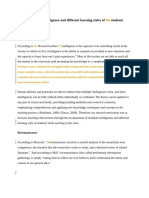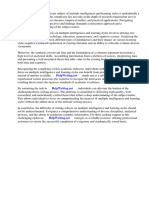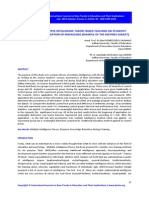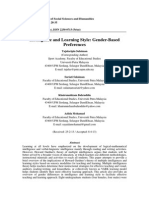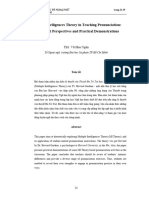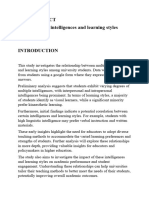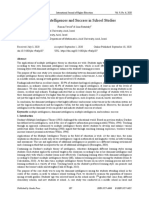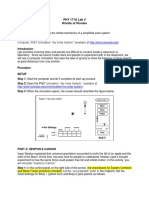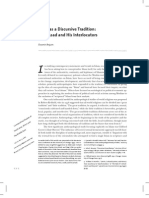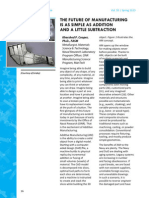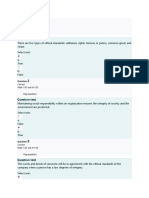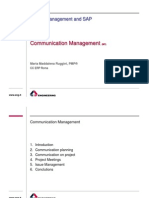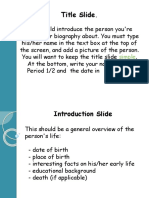Stanford
Stanford
Uploaded by
Surya FahroziCopyright:
Available Formats
Stanford
Stanford
Uploaded by
Surya FahroziCopyright
Available Formats
Share this document
Did you find this document useful?
Is this content inappropriate?
Copyright:
Available Formats
Stanford
Stanford
Uploaded by
Surya FahroziCopyright:
Available Formats
Intervention in School and Clinic
http://isc.sagepub.com Multiple Intelligence for Every Classroom
Pokey Stanford Intervention in School and Clinic 2003; 39; 80 DOI: 10.1177/10534512030390020301 The online version of this article can be found at: http://isc.sagepub.com/cgi/content/abstract/39/2/80
Published by: Hammill Institute on Disabilities
and
http://www.sagepublications.com
Additional services and information for Intervention in School and Clinic can be found at: Email Alerts: http://isc.sagepub.com/cgi/alerts Subscriptions: http://isc.sagepub.com/subscriptions Reprints: http://www.sagepub.com/journalsReprints.nav Permissions: http://www.sagepub.com/journalsPermissions.nav
Downloaded from http://isc.sagepub.com at SAGE Publications on April 11, 2008 2003 Hammill Institute on Disabilities. All rights reserved. Not for commercial use or unauthorized distribution.
Multiple Intelligence for Every Classroom
P O K E Y S TA N F O R D
This article presents an overview of multiple intelligence (MI) theory along with practical applications of the model. In particular, three basic aspects of the theory (teaching strategies, curricular adaptations, and student assessment) are described relative to the infusion of MI theory in general education classrooms to ensure appropriate inclusion for students with mild to moderate disabilities.
80 I NTERVENTION IN S CHOOL AND C LINIC
VOL . 39, N O. 2, N OVEMBER 2003 ( PP. 8085)
Downloaded from http://isc.sagepub.com at SAGE Publications on April 11, 2008 2003 Hammill Institute on Disabilities. All rights reserved. Not for commercial use or unauthorized distribution.
ultiple intelligence (MI) theory has received much attention over the past 20 years (Campbell, 1997; Silver, Strong, & Perini, 1997). Almost 80 years after the first intelligence tests were developed, Howard Gardner challenged the notion that intelligence is something that can be objectively measured and reduced to a single quotient or score. Maintaining that our culture has defined intelligence too narrowly, Gardner proposed in Frames of Mind (1983) the existence of at least seven basic intelligences; since then an eighth has been added (Checkley, 1997; Roper & Davis, 2000). Gardners work has encouraged educators and parents to view children as equals regardless of a quotient produced from an intelligence exam or of academic areas for which they develop competence. Practitioners of MI understand that children do not fit a single prototype. Gardner sought to broaden the perception of human potential beyond the confines of traditional IQ scores, seriously questioning the validity of determining an individuals intelligence through the practice of taking the person out of his or her natural environment and asking him or her to attempt isolated tasks never done before and probably never to be done again. Thus, Gardner suggested educators view intelligence as the capacity for solving problems and fashioning products in context-rich and naturalistic settings (Armstrong, 1994) rather than place the traditional importance on the ability to produce a large quotient.
Defining the Intelligences
Gardner (1997) defined the various intelligence areas as follows: Verbal/linguistic intelligence: the production of language, abstract reasoning, symbolic thinking, conceptual patterning, reading, and writing. Logical/mathematical intelligence: the capacity to recognize patterns, work with abstract symbols (e.g., numbers, geometric shapes), and discern relationships or see connections between separate and distinct pieces of information. Visual/spatial intelligence: visual arts, navigation, mapmaking, architecture, and games requiring the ability to visualize objects from different perspectives and angles. Bodily/kinesthetic intelligence: the ability to use the body to express emotion, to play a game, and to create a new product. Musical/rhythmic intelligence: capacities such as the recognition and use of rhythmic and tonal patterns and sensitivity to sounds from the environment, the human voice, and musical instruments. Interpersonal intelligence: the ability to work cooperatively with others in a small group, as well as the
ability to communicate verbally and nonverbally with other people. Intrapersonal intelligence: the internal aspects of the self, such as knowledge of feelings, range of emotional responses, thinking processes, self-reflection, and a sense of intuition about spiritual realities. Naturalistic intelligence: the ability to recognize patterns in nature and classify objects, the mastery of taxonomy, sensitivity to other features of the natural world, and an understanding of different species. Existential intelligence: the human response to being alive in all ways (Gardner is still not satisfied that he has enough physiological brain evidence to conclusively establish this as an intelligence). Beyond the descriptions of the eight intelligences, certain aspects of the theory are important to remember, especially when working with individuals with disabilities. For example, Armstrong (1994) suggested that four elements be considered. First, each person possesses all eight intelligences. Each person has capacities in all eight intelligences. Of course, the eight intelligences function together in ways unique to each person. Some people appear to possess extremely high levels of functioning in all or most of the eight intelligences, yet others appear to lack all but the most basic aspects of the intelligences. Most fall somewhere in between highly developed in some intelligences, modestly developed in others, and relatively underdeveloped in the rest. Students with learning disabilities often exhibit deficits in verbal/linguistic or logical/mathematical intelligences but show strengths in other areas. Unfortunately, schools put more emphasis on verbal/linguistic and logical/mathematical.
Practices to Emerge
MI theory is perhaps more accurately described as a philosophy of education or an attitude toward learning (Armstrong, 1994), in the spirit of John Deweys ideas (1916, 1938) on progressive education, rather than a set program of fixed techniques and strategies. As such, it offers educators a broad opportunity to creatively adapt its fundamental principles to any number of educational settings. Implications for school reform and classroom application include expanded teaching strategies, curricular adaptations, and expanded student assessment. Indeed unsuccessful, unmotivated students have experienced academic growth when exposed to multifaceted interventions and techniques principled by MI theory (Janes, Koutsopanagos, Mason, & Villaranda, 2000). The teachers role in an MI classroom contrasts sharply with that of a teacher in a traditional classroom (Gardner, 1997). In the traditional classroom, the teacher lectures while standing at the front of the classroom, writes on the board, questions students about the assigned readings or
VOL . 39, N O. 2, N OVEMBER 2003 81
Downloaded from http://isc.sagepub.com at SAGE Publications on April 11, 2008 2003 Hammill Institute on Disabilities. All rights reserved. Not for commercial use or unauthorized distribution.
handouts, and waits as students finish written work. In comparison, in the MI classroom, the teacher continually shifts method of presentation from linguistic to spatial to musical, and so on, often combining intelligences in creative ways. Next, we will look at some practical aspects of MI theory.
Teaching Strategies
MI makes its greatest contribution to education by suggesting that teachers expand their repertoire of techniques, tools, and strategies beyond the typical linguistic and logical ones predominantly used in U.S. classrooms (Campbell, 1997). According to John Goodlads pioneering A Study of Schooling project, which involved researchers observing more than 1,000 classrooms nationwide, nearly 70% of classroom time was consumed by teacher talkmainly teachers talking at students (giving instructions, lecturing). The second, most widely observed activity was students doing written assignments. According to Goodlad (1984), Much of this work was in the form of responding to directives in workbooks or on worksheets (p. 230). In this context, the theory of multiple intelligences functions not only as a specific remedy to one-sidedness in teaching but also as an organizational tool that facilitates and synthesizes existing educational pedagogy. In doing so, it provides s broad range of stimulating curricula to awaken the slumbering brains that Goodlad fears populate our nations schools. MI theory provides an avenue for accomplishing what good teachers have always done: Reach beyond the text to provide varied opportunities for students to learn and show evidence of learning. MI theory provides a framework for teachers to reflect on their best teaching methods and to understand why these methods work (or why they work well for some students but not for others). It also helps teachers expand their teaching repertoire to include a broader range of methods, materials, and tech82 I NTERVENTION IN S CHOOL AND C LINIC
niques for reaching an ever-wider and more diverse range of learners. MI theory opens the door to a wide variety of teaching strategies that can easily be implemented in the classroom. In many cases, these are strategies that have been used for decades by good teachers. In other cases, the theory of MI offers teachers an opportunity to develop innovative teaching strategies. In either case, MI theory suggests that no one set of strategies will work best for all students at all times. All children have different predispositions in the eight intelligences, so any particular strategy is likely to be highly successful with one group of students and less successful with other groups (Silver et al., 1997). For example, teachers who use rhythms, raps, and chants as a pedagogical tool will probably find that musically inclined students respond enthusiastically to this strategy but nonmusical students remain unmoved. Similarly, the use of pictures and images will reach students who are more spatially oriented but perhaps have a different effect on those who are more physically or verbally inclined (see Figure 1). Because of individual differences among students, teachers are best advised to use a broad range of teaching strategies. As long as instructors shift their intelligence emphasis from presentation to presentation, there will always be time during a day when a students most highly developed intelligence is actively involved in learning. Currently, for students with disabilities, it is often only their weakest area that is used for most of the day. Balancing strategies gives equal opportunity to the individual student who struggles with obtaining information through one intelligence and allows the student to use the strengths he or she possesses for learning. Figure 2 shows how teachers can reach all learners by using a thematic approach with concept development and MI.
Expanding Assessment
Effective assessment is in alignment with instructional practices (Bellanca, Chapman, & Swartz, 1994). Changing teaching strategies and curricula without changing assessment methods will not bring about the full benefit of MI theory for teaching and learning. Thus, if MI theory is to be used in classrooms, teachers must change the way they assess student learning (Chapman, 1993). Traditional assessment limits learners to a pencil-and-paper test as the primary means of demonstrating knowledge and skills. MI theory brings about an awareness of many assessment strategies that allow students to show they understand and can use new information in unique ways. Assessment alternatives include logs and journals, graphic organizers, observational checklists, video samples, rubrics, miscue analyses, and portfolios. Such alternative forms of assessment offer students the potential to demonstrate learning content in a variety of ways. An example is a
Downloaded from http://isc.sagepub.com at SAGE Publications on April 11, 2008 2003 Hammill Institute on Disabilities. All rights reserved. Not for commercial use or unauthorized distribution.
Figure 1. Multiple intelligence activites related to the topic of fractions.
math lesson or unit in which the teacher assesses cooperative groups (interpersonal intelligence), hands-on manipulative (bodily/kinesthetic intelligence), or reflection logs (intrapersonal intelligence). To facilitate the use of multiple assessments for the multiple intelligences, teachers will need to rethink how students can show what they know. The multiple intelli-
gences strengths self-checklist (see Figure 3) allows learners to begin to self-identify where their strengths are within the differing intelligences. Authentic assessment offers opportunities for students with learning disabilities by allowing an alternative means of measuring growth and development. When a learner can help with the identification of a strength, assessments can be focused on
VOL . 39, N O. 2, N OVEMBER 2003 83
Downloaded from http://isc.sagepub.com at SAGE Publications on April 11, 2008 2003 Hammill Institute on Disabilities. All rights reserved. Not for commercial use or unauthorized distribution.
reaching the learners full potiental. Miscue analysis, for example, allows teachers to focus specific and intensive instruction on an individual basis by identifying the need of the learner in the context of strengths (Reutzel & Cooter, 2003). New assessments should not focus on whether or not students can acquire knowledge but on whether or not they can acquire the disposition to use skills and strategies appropriately. Recent studies have suggested that poor thinkers and poor problem solvers may possess the skills they need but fail to use them in certain tasks (Burke, 1994). Integration of learning, motivation, collaboration, and metacognition all contribute to lifelong learning. Assessments that move beyond measuring knowledge and skills and begin measuring the disposition of using the knowledge/skills will better meet the needs of learners. In the MI classrooms, the possibilities for assessing student learning are as numerous as the options for organizing curricula and teaching strategies (Bellanca et al., 1994). In the traditional classroom, assessment drives instruction. In the multiple intelligence classroom, assessment and instruction are partners. The MI classroom provides the environment for teachers to use varied teaching strategies, expanded curricula, and authentic assessment to provide creative and active learning that engages all students (especially those with disabilities) in the construction of their own learning.
ABOUT
THE
AUTHOR
Pokey Stanford, EdD, is an assistant professor of education at William Carey College. Her current interests include MI theory and technology as intervention tools to further facilitate inclusive environments for all learners. She was a classroom teacher for 7 years. Address: Pokey Stanford, William Carey College, 498 Tuscan Ave., WCC Box 3, Hattiesburg, MS 39401-5461; e-mail: Barbara.Stanford@wmcarey.edu
REFERENCES
Armstrong, T. (1994). Multiple intelligences in the classroom. Alexandria, VA: ASCD. Bellanca, J., Chapman, C., & Swartz, E. (1994). Multiple assessments for multiple intelligences. Palatine, IL: IRI/Skylights Publishing. Burke, K. (1994). The mindful school: How to assess student learning. Palatine, IL: IRI/Skylights Publishing. Campbell, L. (1997). Variations on a themeHow teachers interpret MI theory. Educational Leadership, 55(1), 1419. Chapman, C. (1993). If the shoe fits: How to develop multiple intelligences in the classroom. Palatine, IL: IRI/Skylights Publishing. Checkley, K. (1997). The first seven . . . and the eighth: A conversation with Howard Gardner. Educational Leadership, 55(1), 813. Dewey, J. (1916). Democracy and education. New York: Macmillan. Dewey, J. (1938). Experience and education. Toronto: Macmillan. Gardner, H. (1983). Frames of mind: The theory of multiple intelligences. New York: Basic Books. Gardner, H. (1997). Multiple intelligence as a partner in school improvement. Educational Leadership, 55(1), 2021.
Figure 2. Multiple intelligence activities related to the topic of patriotism across grade levels.
84 I NTERVENTION IN S CHOOL AND C LINIC
Downloaded from http://isc.sagepub.com at SAGE Publications on April 11, 2008 2003 Hammill Institute on Disabilities. All rights reserved. Not for commercial use or unauthorized distribution.
Figure 3. Multiple intelligences strengths.
Goodlad, J. I. (1984). A place called school: Prospects for the future. New York: McGraw-Hill. Janes, L. M., Koutsopanagos, C. L., Mason, D. S., & Villaranda, I. (2000). Improving student motivation through the use of engaged learning, cooperative learning and multiple intelligences. Chicago: Masters action research project, Saint Xavier University and Skylight fieldbased masters program. Roper, B., & Davis, D. (2000). Howard Gardner: Knowledge, learning
and development in drama and arts education. Research in Drama Education, 5(2), 234. Reutzel, D. R., & Cooter, R. B., Jr. (2003). Strategies for reading assessment and instruction: Helping every child succeed (2nd ed.). Upper Saddle River, NJ: Merrill/Prentice Hall. Silver, H., Strong, R., & Perini, M. (1997). Integrating learning styles and multiple intelligence. Educational Leadership, 55(1), 2227.
VOL . 39, N O. 2, N OVEMBER 2003 85
Downloaded from http://isc.sagepub.com at SAGE Publications on April 11, 2008 2003 Hammill Institute on Disabilities. All rights reserved. Not for commercial use or unauthorized distribution.
You might also like
- The Resilience Doughnut - Building Resilience in Children and Young PeopleDocument2 pagesThe Resilience Doughnut - Building Resilience in Children and Young Peopleapi-251598265No ratings yet
- Jesus Appeals For LoveDocument7 pagesJesus Appeals For LoveThe Fatima Center100% (1)
- Katz, Postal - 1964 - An Integrated Theory of Lingusitc Descriptions PDFDocument16 pagesKatz, Postal - 1964 - An Integrated Theory of Lingusitc Descriptions PDFProfesseur Mario0% (1)
- Kokology GameDocument12 pagesKokology GameAbigail Ranque-Dia100% (1)
- Enhancing Language Teaching and Learning by Keeping Individual Differences in PerspectiveDocument9 pagesEnhancing Language Teaching and Learning by Keeping Individual Differences in PerspectiveYum BuckerNo ratings yet
- Howard GardnerDocument6 pagesHoward GardnerBrengelle LausaNo ratings yet
- Enhancing Academic Performance of Disabled Students Through Multiple Intelligences Based ProgrammesDocument10 pagesEnhancing Academic Performance of Disabled Students Through Multiple Intelligences Based ProgrammesUnknownNo ratings yet
- Tempa Rinchen... DoneDocument6 pagesTempa Rinchen... Donetemparonaldo7No ratings yet
- Thesis About Multiple Intelligence and Learning StylesDocument4 pagesThesis About Multiple Intelligence and Learning Stylesdnnpkqzw100% (1)
- MI Related LitDocument10 pagesMI Related LitAMYNo ratings yet
- Mulitple IntelligenceDocument7 pagesMulitple IntelligenceCosmin RadulescuNo ratings yet
- Thesis Proposal SmithDocument18 pagesThesis Proposal SmithLô Xuân ThốngNo ratings yet
- English Language PedagogyDocument7 pagesEnglish Language PedagogyAddinNo ratings yet
- Chapter 1 To 3Document115 pagesChapter 1 To 3TeacherBechay VlogNo ratings yet
- Chapter 1-5 FinalDocument45 pagesChapter 1-5 FinalJohn ReynierNo ratings yet
- Multiple Intelligences - Howard Gardner (Prof - BLH)Document4 pagesMultiple Intelligences - Howard Gardner (Prof - BLH)Prof. (Dr.) B. L. HandooNo ratings yet
- Multiple Intelligences in The Classroom, 4th EdDocument8 pagesMultiple Intelligences in The Classroom, 4th EdjennylynNo ratings yet
- Multiple Intelligence TheoryDocument4 pagesMultiple Intelligence Theoryapi-375399756100% (1)
- Multiple Intelligence PDFDocument56 pagesMultiple Intelligence PDFMilgam SalamNo ratings yet
- 9.2 Multiple Intelligences GardnerDocument2 pages9.2 Multiple Intelligences Gardneranelemlotshwa119No ratings yet
- Modern Theories On EducationDocument4 pagesModern Theories On Educationeirinibat100% (3)
- Designing Effective ProjectsThinking Skills Frameworks Learning StylesDocument5 pagesDesigning Effective ProjectsThinking Skills Frameworks Learning StylesmuratvasileNo ratings yet
- Activity 2 SociolinguisticDocument11 pagesActivity 2 SociolinguisticLiriolyn Taguiam Bitamog-PacursaNo ratings yet
- Lesson 1Document4 pagesLesson 1ivan.el.rey1340No ratings yet
- Multiple Intelligences - Adi Wibowo&faatin Mahiroh NDocument15 pagesMultiple Intelligences - Adi Wibowo&faatin Mahiroh NFaatin Mahiroh NisaNo ratings yet
- The Effects of Multiple Intelligence Theory Based Teaching On Students' Achievement and Retention of Knowledge (Example of The Enzymes Subject)Document10 pagesThe Effects of Multiple Intelligence Theory Based Teaching On Students' Achievement and Retention of Knowledge (Example of The Enzymes Subject)Surya FahroziNo ratings yet
- Why Teach Science in School?Document30 pagesWhy Teach Science in School?Samuel Enrique Cano PatocNo ratings yet
- Creating The Opportunity To LearnDocument41 pagesCreating The Opportunity To LearnCachanda OrellanaNo ratings yet
- Intelligence and Learning Style: Gender-Based Preferences: International Review of Social Sciences and HumanitiesDocument8 pagesIntelligence and Learning Style: Gender-Based Preferences: International Review of Social Sciences and Humanitiesaderina9032No ratings yet
- The Multiple Intelligences of Thegrade Seven (7) Students: A Basis For Differentiated Learning ActivitiesDocument34 pagesThe Multiple Intelligences of Thegrade Seven (7) Students: A Basis For Differentiated Learning ActivitiesChristian AndradeNo ratings yet
- Multiple IntelligencesDocument6 pagesMultiple IntelligencesNorman SernaNo ratings yet
- Application of Multiple Intelligence in Teaching The Learners of Secondary Education Using K12 ProgramDocument31 pagesApplication of Multiple Intelligence in Teaching The Learners of Secondary Education Using K12 ProgramPerry Arcilla SerapioNo ratings yet
- Multiple Intelligences Theory in Teaching Pronunciation: Theoretical Perspectives and Practical DemonstrationsDocument16 pagesMultiple Intelligences Theory in Teaching Pronunciation: Theoretical Perspectives and Practical Demonstrationspham giahuyNo ratings yet
- Multiple IntelligenceDocument5 pagesMultiple IntelligencepakarpuangNo ratings yet
- Multiple IntelligencesDocument10 pagesMultiple IntelligencesDianne Mojico100% (1)
- Multiple IntelligencesDocument16 pagesMultiple IntelligencesGustavo LombaNo ratings yet
- Multiple IntelligencesDocument11 pagesMultiple IntelligencesIsabel HughesNo ratings yet
- Thesis Chapter 1Document10 pagesThesis Chapter 1Maria Camille Villanueva SantiagoNo ratings yet
- The Effectsofthe Multiple Intelligence Teaching Strategyon Academic Achievementof 8 TH Grade MathstudentsDocument15 pagesThe Effectsofthe Multiple Intelligence Teaching Strategyon Academic Achievementof 8 TH Grade Mathstudentsellala.assalaNo ratings yet
- Multiple Intelligences in The Classroom, 4th EdDocument2 pagesMultiple Intelligences in The Classroom, 4th EdRiza WidyaNo ratings yet
- Educational EmphasesDocument44 pagesEducational EmphasesjniaNo ratings yet
- Multiple Intelligences2Document3 pagesMultiple Intelligences2pdb1623No ratings yet
- 659 2172 1 PBDocument6 pages659 2172 1 PBSphelly ZunguNo ratings yet
- Educ 105 Activity 1&2Document6 pagesEduc 105 Activity 1&2Ann C. CasanNo ratings yet
- The Theory of Learning StylesDocument3 pagesThe Theory of Learning StylesBraian Torres LmlNo ratings yet
- Teaching to student diversity in higher education how Multiple Intelligence Theory can helpDocument15 pagesTeaching to student diversity in higher education how Multiple Intelligence Theory can helpNey AcostaNo ratings yet
- Bcvs Project Title: Multiple Intelligences and Learning StylesDocument17 pagesBcvs Project Title: Multiple Intelligences and Learning StylesasarvigaNo ratings yet
- Teaching English To Children A Unique, Challenging Experience For Teacher, EfDocument5 pagesTeaching English To Children A Unique, Challenging Experience For Teacher, EfDellaCNazirahJatirinNo ratings yet
- DiversityDocument4 pagesDiversityMayRoseLazoNo ratings yet
- Additional Social StudiesDocument14 pagesAdditional Social StudiesRonald CarniceNo ratings yet
- Managing The Classes by Using Multiple Intelligence InstructionDocument6 pagesManaging The Classes by Using Multiple Intelligence InstructionMuhammad RusliNo ratings yet
- Multiple Intelligences and Success in School Studies: International Journal of Higher Education Vol. 9, No. 6 2020Document11 pagesMultiple Intelligences and Success in School Studies: International Journal of Higher Education Vol. 9, No. 6 2020pauleen remetioNo ratings yet
- Thesis ProposalDocument14 pagesThesis ProposalMarvin TabilinNo ratings yet
- The Application of Multiple Intelligence Theory in English Language Learning and TeachingDocument4 pagesThe Application of Multiple Intelligence Theory in English Language Learning and Teachingammukutty gopNo ratings yet
- Multiple Intelligence: Shobitha Sankar. S 1st M.R. SCDocument12 pagesMultiple Intelligence: Shobitha Sankar. S 1st M.R. SCShobithaNo ratings yet
- Review of Related LiteratureDocument9 pagesReview of Related LiteratureVaneza Damaulao Lumictin100% (1)
- Chapter 7 Techniques On How To Teach Science in Elementary LevelsDocument13 pagesChapter 7 Techniques On How To Teach Science in Elementary Levelsscarletash169No ratings yet
- The Practice of Gardner's Multiple Intelligences Theory in The ClassroomDocument13 pagesThe Practice of Gardner's Multiple Intelligences Theory in The ClassroomSphelly ZunguNo ratings yet
- Educ. 5410 PA - Week 3Document7 pagesEduc. 5410 PA - Week 3Ani JonesNo ratings yet
- Learning Environments and Implications in A 5th Grade Classroom.Document5 pagesLearning Environments and Implications in A 5th Grade Classroom.Luisa González VarelaNo ratings yet
- The ProblemDocument26 pagesThe ProblemCarlito AglipayNo ratings yet
- The Theory of Multiple Intelligences and Critical ThinkingDocument16 pagesThe Theory of Multiple Intelligences and Critical ThinkingLluvia lluviasNo ratings yet
- Pasumbal Gillianne Grace M. FACILITATING SEMIFINALDocument5 pagesPasumbal Gillianne Grace M. FACILITATING SEMIFINALKhristel AlcaydeNo ratings yet
- 01Document31 pages01Surya FahroziNo ratings yet
- Aarhat Multidisciplinary International Education Research Journal (AMIERJ) (Document6 pagesAarhat Multidisciplinary International Education Research Journal (AMIERJ) (Surya FahroziNo ratings yet
- The Effects of Multiple Intelligence Theory Based Teaching On Students' Achievement and Retention of Knowledge (Example of The Enzymes Subject)Document10 pagesThe Effects of Multiple Intelligence Theory Based Teaching On Students' Achievement and Retention of Knowledge (Example of The Enzymes Subject)Surya FahroziNo ratings yet
- Teaching Strategies For Intrapersonal Intelligence: One-MinutereflectionperiodsDocument4 pagesTeaching Strategies For Intrapersonal Intelligence: One-MinutereflectionperiodsSurya FahroziNo ratings yet
- Media Selection: Mapping Technologies To IntelligencesDocument8 pagesMedia Selection: Mapping Technologies To IntelligencesSurya FahroziNo ratings yet
- Synthesis Chapter 2 First HalfDocument6 pagesSynthesis Chapter 2 First HalfPrincess EngresoNo ratings yet
- Architecture - January 2019Document20 pagesArchitecture - January 2019ArtdataNo ratings yet
- Doctrine of Unconscionability Its DevelopmeDocument17 pagesDoctrine of Unconscionability Its DevelopmeLenny JM100% (1)
- Where Is Art Space, Time, and Location in Contemporary Art - Bibis - IrDocument243 pagesWhere Is Art Space, Time, and Location in Contemporary Art - Bibis - IrKriengsak PhoosantisampanNo ratings yet
- Safety Hazard Identification On Construction ProjectsDocument19 pagesSafety Hazard Identification On Construction Projectshayatmdazhar100% (2)
- Here by MeDocument2 pagesHere by MeTRISH BOCANo ratings yet
- PHY 171A Lab 4Document5 pagesPHY 171A Lab 4james100% (1)
- Lesson Plan Year OneDocument5 pagesLesson Plan Year OneAliff TgEzaniNo ratings yet
- Anjum - Islam As Discursive Religion Talal Asad and His InterlocutersDocument17 pagesAnjum - Islam As Discursive Religion Talal Asad and His InterlocutersMariam Sheibani100% (1)
- The Future of Manufacturing Is As Simple As Addition and A Little SubtractionDocument4 pagesThe Future of Manufacturing Is As Simple As Addition and A Little SubtractionU.S. Naval Research LaboratoryNo ratings yet
- 3 Seismic Rays Earth StructureDocument28 pages3 Seismic Rays Earth StructureNANKADAVUL007No ratings yet
- Servicescape Bharati AirtelDocument3 pagesServicescape Bharati AirteldacchuNo ratings yet
- UGRD-BAMM6205-2233T ReviewerDocument8 pagesUGRD-BAMM6205-2233T ReviewerWawi Dela RosaNo ratings yet
- Organizational Behavior and Human Decision ProcessesDocument12 pagesOrganizational Behavior and Human Decision ProcessesGarriy ShteynbergNo ratings yet
- Communication Management: Project Management and SAPDocument48 pagesCommunication Management: Project Management and SAPthi.morNo ratings yet
- Devlok With Devdutt PattanaikDocument194 pagesDevlok With Devdutt PattanaikSabyasachi Mukhopadhyay88% (8)
- Question 1 of 2: Word CountDocument5 pagesQuestion 1 of 2: Word CountJeffrey SutedjaNo ratings yet
- Simple Sentence Structure of Standard Arabic Language PDFDocument25 pagesSimple Sentence Structure of Standard Arabic Language PDFtomasgouchaNo ratings yet
- 4120-Bachelor of Arts PDFDocument87 pages4120-Bachelor of Arts PDFAbha YadavNo ratings yet
- Guidelines Writing A BiographyDocument13 pagesGuidelines Writing A BiographyPromise100% (1)
- Subject: Dynamics Kinematics of Particles: Newton's Second LawDocument11 pagesSubject: Dynamics Kinematics of Particles: Newton's Second LawJamaliah JajaNo ratings yet
- Q2 Week 7 21st CLDocument3 pagesQ2 Week 7 21st CLRonald RomeroNo ratings yet
- CaesuraDocument21 pagesCaesuram54237No ratings yet
- The Nature of Proof in The Interpretation of PoetryDocument6 pagesThe Nature of Proof in The Interpretation of PoetryMiriamNo ratings yet
- Raju 1952Document24 pagesRaju 1952Paras SinhaNo ratings yet
- UP HW CH 5 SDocument5 pagesUP HW CH 5 SCarlo DomanaisNo ratings yet







